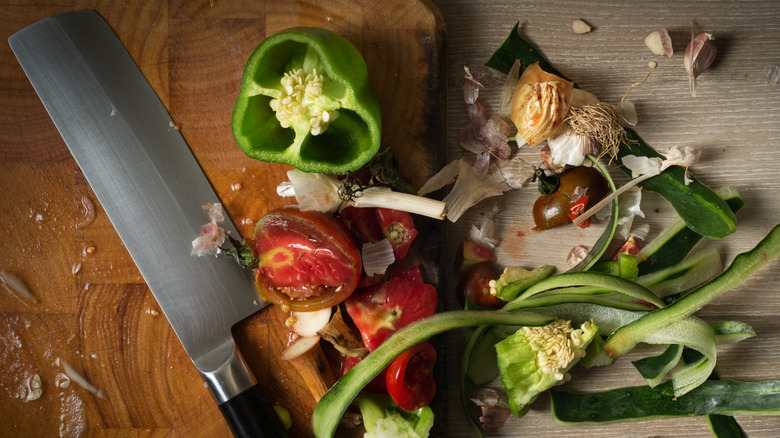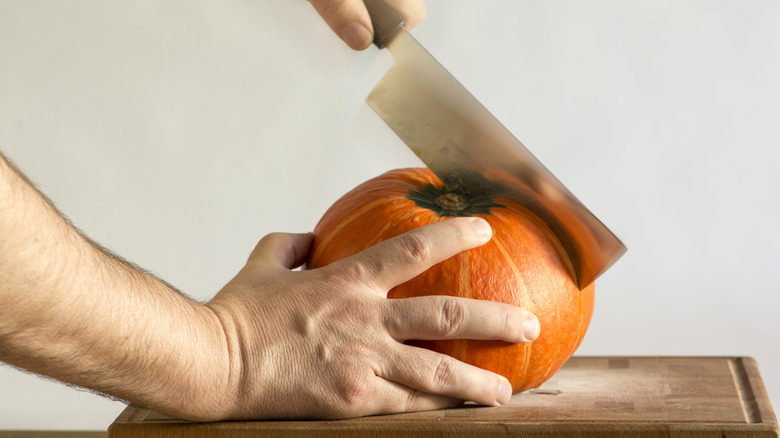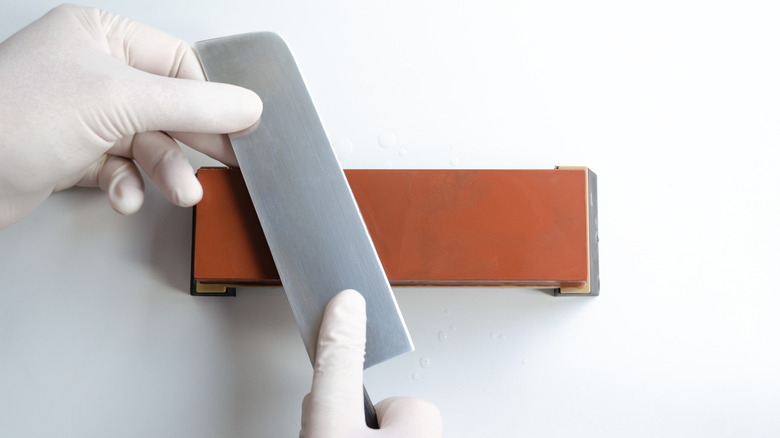The Japanese Knife That's Designed To Cut Vegetables
Why have an arsenal of specialty knives designed for chopping different types of food? You may not want to ask that in the presence of a professional chef. It's like wondering why marathon runners don't just wear any old tennis shoe. Nuanced details can affect precision, execution, quality, and the "cutting edge" — literally. When it comes to preparing food, whether professionally or in your own kitchen, having the appropriate type of knife falls under the adage, "if you're going to do something, then do it right."
High-end kitchen stores present a dizzying array of culinary tools, but few are more impressive than knives. The sharp silver parade glistens with meat cleavers, serrated carvers, bread and utility knives, chef's and santoku knives, as well as ones for boning, paring, filleting, chopping, slicing, dicing, and slivering. However, truly embracing the minutia of meal artistry requires even more distinctions -– including a dedicated knife for cutting vegetables.
It's no surprise the ultimate vegetable knife comes from Japan, where knives are highly revered for quality and precision. In Japan, vegetables are meant to be eaten with chopsticks, notes Koi, which requires careful chopping and slicing. Even more important is the visual component of Japanese cuisine. The art of carving vegetables and fruits into shapes carries its own name: mukimono, which essentially means food art, according to Kobe Jones.
Fortunately, the premier Japanese vegetable cutting knife is available in many kitchen stores and online outlets -– if you're prepared to make a considerable investment in preparing a fresh-veg bounty.
The Japanese usuba knife
Japanese knives carry descriptive monikers such as gyuto, bunka, yanagiba, and the multipurpose santoku knife, notes Sharp Edge. Each is dedicated to specific purposes in the kitchen, including the acclaimed usuba knife for chopping vegetables. The word usuba translates as "thin blade" and features a razor-sharp edge on one side only, which thinly and quickly slices raw vegetables and fruits without excessive contact with the steel, explains the Japanese Knives Guide. This helps the produce stay fresh and appealing due to a decreased chance of cell-wall damage, discoloration, and flavor reduction caused by oxidation.
The traditional usuba vegetable knife stands out for its rectangular shape and boxy square tip, as well as extra length that's convenient for even slicing and chopping bulky items such as lettuce. It also features a resourceful middle section that allows specialty cutting techniques such as katsuramuki rotary peeling, according to Koi, who cautions that a usuba knife takes some practice to master the art of single-bevel cutting. Two types of usuba knives are available: the traditional Kanto version sporting the square tip and the lesser-known Kansai (or Kamagata) style with a pointed tip for fine precision or artful cutting, notes Korin.
Usuba has a cousin
Usuba knives aren't the only Japanese option for vegetable cutting. The similar-looking nakiri knife lands within the same family of slicers designed specifically for produce preparation. Characteristics are similar, particularly the long rectangular shape and square tip, according to Koi -– but the nakiri has a double bevel, similar to Western-style knives. It's considered more utilitarian in nature and is made exclusively for chopping. It works well for vegetables and fruits with tougher skins, such as squashes and melons.
Price can be a consideration for many Japanese knives due to handmade small-batch construction, multiple forged steel layers, and high-end materials, explains Oishya. If you're serious about cooking but don't want to slice off a major chunk of your culinary budget, you can find the same usuba or nakiri styles made with steel from various knife-making countries. Japanny sells affordable hammered and Damascus stain-resistant steel usuba knives at fair prices, while the Artisan series from Cutluxe offers a nakiri vegetable knife made from German high-carbon steel that's hand-sharpened on each side of the blade. It also sports a sturdy ergonomic pakkawood handle for stability and longevity.


